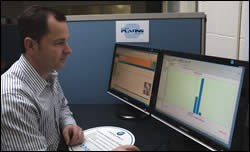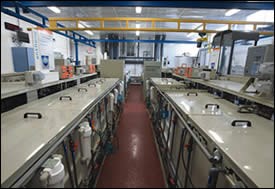From Lab to Production
Software helps automate plating process control, documentation
In February, Enthone Inc. (West Haven, CT) opened an advanced applications laboratory in West Haven that the company believes will drive technical innovation, customer productivity, and industry best practices for many years to come.
The state-of-the-art lab houses multiple plating lines that enable Enthone personnel and customers to work collaboratively to develop new processes using Enthone chemistries for functional, decorative and electronics applications. These processes encompass 90% of Enthone’s products, including hard chrome, electroless nickel, passivates, zinc and zinc alloys, plating on plastics, precious metals and printed wiring board (PWB) plating processes. “All the processes in the lab are what we consider our best-in-class processes,” says applications and technology manager Robert Collin. “The philosophy is, if you’re going to help your customers solve a problem, you’ll want to use your best chemistries and your best procedures. That’s really what the lab is for.”
The mission of the lab and its dedicated staff—plus applications and R&D personnel who come and go as they work on specific projects—also includes:
- Evaluation and validation of Enthone processes prior to beta-site field testing
- In-depth training and demonstration of process capabilities to Enthone personnel and select customers
- Identification and implementation of the best processing methodologies and operating windows for the company’s new and emerging technologies
- Collaborative work with key customers to develop unique plating solutions
- Training of young plating engineers via internship programs with colleges and universities.
The facility also serves as a central location for the Enthone Americas Plating Academy, a training program aimed at enabling employees and select customers to gain technical knowledge about the company’s processes and technologies.
“Many companies have pilot facilities,” Collin says. “What we’re trying to do is raise the bar for ourselves and the industry in terms of developing and testing new and emerging technologies, so we know our processes are well tested and tried and true before they go out into the field.”
Enabling Software
One tool helping to ensure that procedures and processes developed in the applications lab transfer into customer facilities as robust production plating processes is software supplied by TrueLogic Co. LLC (Plano, TX). Designed to control and automate the management of chemistries, coatings and wet processes, the company’s TrueChem software ensures consistent, repeatable application of best practices by automating all process activities, computations, data logging and statistical process control to ensure that the defined methods and procedures are consistently executed and measured.
Collin says the package allows Enthone to ensure the consistency of processes developed in the lab by removing the possibility of human error from operations ranging from tank analysis to specific procedures for line operation. “The software will let you know about concentrations, needed additions—it can even subtract chemicals out of inventory for you,” he explains. “So it really just removes any chance of, for example, a decimal point being in the wrong spot or some similar error.
“Once you have a process down in the lab, it’s not that difficult to go to full production,” Collin says. “Tank sizes in the lab range from a 25-gal pretreatment tank up to a 70-gal process tank, so it’s not like we’re going from a beaker to production. The software helps us scale up processes from lab to production by enabling us to maintain and document the status of the chemistry from makeup through production and going forward from there. It really does not allow you to get outside the process ranges that have been set, so you know that any defects you may have are not caused by a chemistry issue.” The capability the software provides allows users to run their processes well within six-sigma limits, he adds.
According to Collin, the application development process starts when a customer wishes to collaborate with Enthone on a new or emerging technology application, or wish to resolve a specific plating challenge. “When a customer comes to us with a part, we bring it into the lab and perform extensive experiments to find the correct process parameters and ranges for the application,” he explains. “All that data is then sent to the customer’s TrueChem software to enable them to maintain the process within those parameters.
“It’s all based on our customers’ needs, which in turn are based on their customers’ specifications,” Collin continues. “They basically tell us what their specs are, come into the lab with us, and we go forward together to try to develop a best-in-class process for their application. We experiment with different process parameters and chemistry ranges to see which ones work best for their part, then we make samples for testing. Based on test results the customer determines which application suits their needs the best.”
Boosting Consistency
According to Matt Akin, president of TrueLogic, his company’s software helps users boost process consistency and enable continuous improvement. Consistency includes two major areas: scheduling of both tests and preventive maintenance, and procedures and actions,” Akin says. “The software provides electronic procedures and basically forces personnel to follow them. It does that using a variety of techniques. It can notify supervisors, it can even shut down the line or a specific piece of process equipment. Users can decide what level of control they want to implement.”
Akin says the software is widely applied in customer service labs at chemistry suppliers and also by plating equipment suppliers, but Enthone is taking its use to another level. “The relationship between TrueLogic and Enthone was really driven by [Enthone VP—Americas] Terrence Copeland, who recognizes its value for Enthone and its customers,” he says. “We’ve been trying to help chemistry suppliers and plating equipment suppliers see how the software can help their customers better utilize their chemistries and get better results. Terry Copeland saw that. As a result, Enthone recommends our software to many of their customers, and many of their top-level customers are already using it.”
TrueLogic chief technology officer Roger Smith says the package can provide functionality at a range of levels, up to and including automated additions and analysis with the proper hardware in place. “But the heart and soul of it is collecting data in whatever way the customer chooses, manual or automated, and making decisions based on that data that can include scheduling of additions, dumps, remakes or any other type of maintenance that needs to occur,” Smith says.
According to Smith, one of the package’s main tools is a screen called the “dashboard”—a graphical representation of the status of all tanks involved in a process. “The dashboard provides easy-to-see visual status of every tank in the processes being monitored,” he explains. “It makes all the issues visible to all who care.”
Smith says this can have an interesting effect on process problems that border on chronic—for example, a concentration, temperature or other process parameter that may run out of spec as often as not. “When a problem shows up red on the dashboard, it tends to get all kinds of attention,” he says. “So the software can actually change people’s attitudes about what have been chronic problems.”
Smith attributes this effect to just giving plant personnel an opportunity to make use of data that is routinely collected on many processes. “Collecting data is great, but the attitude can be that it’s just data for the sake of data,” he says. “When it’s up there on the dashboard and it’s red and it’s highly visible, people start taking more care and addressing some of the problems. And, it makes management more efficient because it tracks the data for them and provides status on critical variables.”
According to Smith, the software can also be a good stepping stone toward more automation for many shops. “You have to have control of your process before you automate it; otherwise you’re automating something that’s not working,” he says. “What TrueChem really does is give users the ability to gain control of their processes and enable them to get to a point where automation may begin to make sense.”
Akin says a typical plating job shop could be up and running with TrueChem relatively quickly depending on the level of documentation the shop is currently doing. “Based on an average-size plating shop—say 60 tanks—if they have good documentation, it could take as little as a week for us to build a database and be ready to start inputting the data,” he says.
More Benefits
According to Akin, the software also provides many other benefits for users besides better process control, including improved time management for managers and engineering personnel, improved documentation and even marketing.
“In-house, the real value of the package is as a proactive tool that notifies engineers or managers of an issue or a potential issue before it becomes a real problem,” he says. “So engineers and quality managers aren’t fighting fires all day, they’re spending their time concentrating on process improvement and they’re notified by the software if something needs their immediate attention.
“It also provides a high level of process documentation that can be used, for example, if there are problems with a shipment of parts to a customer,” Akin continues. “It can even enable users to track back to the lot number of chemicals and titrants used on the parts, and that information could then be followed back through the chemical suppliers’ manufacturing process.”
According to Akin, platers involved in the aerospace industry are already using this functionality, and he believes it will become more widely used in the future. “I generally figure that, if the aerospace industry is doing it now, pretty much everyone will be doing it in ten years,” he says.
For marketing purposes, the package enables users to show customers that they have a high level of control and documentation of their processes. “That’s a powerful tool,” Akin says. “Prior to TrueChem, the lab was the last place that many of our users would want to take their customers. Now the lab is often the first place they take customers and potential customers to show them how they’re controlling the quality of products they can provide.”
Read Next
A ‘Clean’ Agenda Offers Unique Presentations in Chicago
The 2024 Parts Cleaning Conference, co-located with the International Manufacturing Technology Show, includes presentations by several speakers who are new to the conference and topics that have not been covered in past editions of this event.
Read MoreDelivering Increased Benefits to Greenhouse Films
Baystar's Borstar technology is helping customers deliver better, more reliable production methods to greenhouse agriculture.
Read MoreEpisode 45: An Interview with Chandler Mancuso, MacDermid Envio Solutions
Chandler Mancuso, technical director with MacDermid Envio discusses updating your wastewater treatment system and implementing materials recycling solutions to increase efficiencies, control costs and reduce environmental impact.
Read More













.jpg;maxWidth=300;quality=90)












